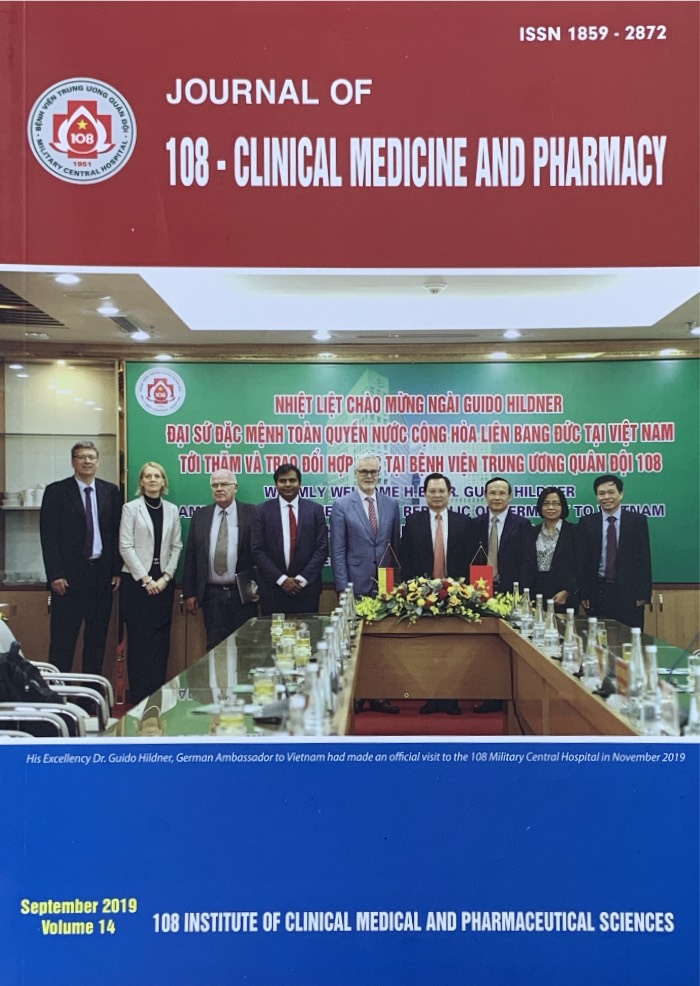The role of the quantitative method in the assessment of hepatocellular carcinoma wash-in and wash-out phases by contrast enhanced ultrasound
Main Article Content
Keywords
Tóm tắt
Objective: To quantitative analysis the wash-in and wash-out of hepatocellular carcinoma (HCC) by contrast enhanced ultrasound and to find out the correlation between these characterizations with tumor size and tumor differentiations. Subject and method: This study included 134 patients with 134 HCC nodules confirmed by histopathology from February 2014 to May 2017. All patients were evaluated by contrast enhanced ultrasound with contrast agent SonoVue (Bracco Company, Netherlands), using US machine (Philips EPIQ 5G, US) that has contrast programe including contrast auto-tracking software ROI, following the Guideline of WFUMB and EFSUMB 2012. Result: There were undifferentiated between HCCs with level’s size (< 20mm, 20 - < 40mm, ≥ 40mm), the well-differentiated HCCs and the moderately to poorly HCCs from time to peak (TP) and enhancement slope (ES). However, there were differentiated between HCCs with level’s size (< 20mm, 20 – < 40mm, ≥ 40mm), the well-differentiated HCCs and the moderately to poorly HCCs from wash-out time and clearance slope with statistically significant (p<0.05). Conclusion: The HCCs nodules showed a “fast-in” in the artery phase and “fast-out” in the portal and late phase. The wash-out time and clearance slope correlate with HCCs’s size and play an important role in predicting the differentiation of HCCs.
Article Details
Các tài liệu tham khảo
2. Bolondi L, Gaiani S, Celli N et al (2005) Characterization of small nodules in cirrhosis by assessment of vascularity: The problem of hypovascular hepatocellular carcinoma. Hepatology 42(1): 27-34.
3. Choi IY, Lee JM, Sirlin CB (2014) CT and MR imaging diagnosis and staging of hepatocellular carcinoma: Part I. Development, Growth, and Spread: Key Pathologic and Imaging Aspects. Radiology 272: 635–654.
4. Claudon M, Dietrich CF, Choi BI et al (2013) Guidelines and good clinical practice recommendations for contrast enhanced ultrasound (CEUS) in the liver--update 2012: A WFUMB-EFSUMB initiative in cooperation with representatives of AFSUMB, AIUM, ASUM, FLAUS and ICUS. Ultraschall Med 34(1): 11-29.
5. Hayashi M, Matsui O, Ueda K et al (2002) Progression to hypervascular hepatocellular carcinoma: Correlation with intranodular blood supply evaluated with CT during intraarterial injection of contrast material. Radiology 225(1): 143-149.
6. Hirohashi S, Ishak KG, Kojiro M et al (2000) Hepatocellular carcinoma. In: Aaltonen LA, Hamilton SR (eds). Pathology and Genetics of Tumors of the Digestive System: 159-172.
7. Kudo M (2002) Imaging blood flow characteristics of hepatocellular carcinoma. Oncology 62(1): 48-56.
8. Kudo M, Izumi N, Kokudo N et al (2011) Management of hepatocellular carcinoma in Japan: Consensus-Based clinical practice guidelines proposed by the Japan Society of Hepatology (JSH) 2010 updated version. Dig Dis 29(3): 339-364.
9. Mohamed AM, Elmaaty MEGA, Ibrahim AM et al (2014) Diagnosis of arterioportal shunts in cases of hepatocellular carcinoma using multi detector CT: Impact on clinical management. The Egyptian Journal of Radiology and Nuclear Medicine 45: 25-33.
10. Xu JF, Liu HY, Shi Y et al (2011) Evaluation of hepatocellular carcinoma by contrast-enhanced sonography - correlation with pathologic differentiation. J Ultrasound Med 30: 625-633.
11. Yang ZF, Poon RT (2008) Vascular changes in hepatocellular carcinoma. Anat Rec (Hoboken) 291(6): 721-734.
 ISSN: 1859 - 2872
ISSN: 1859 - 2872
